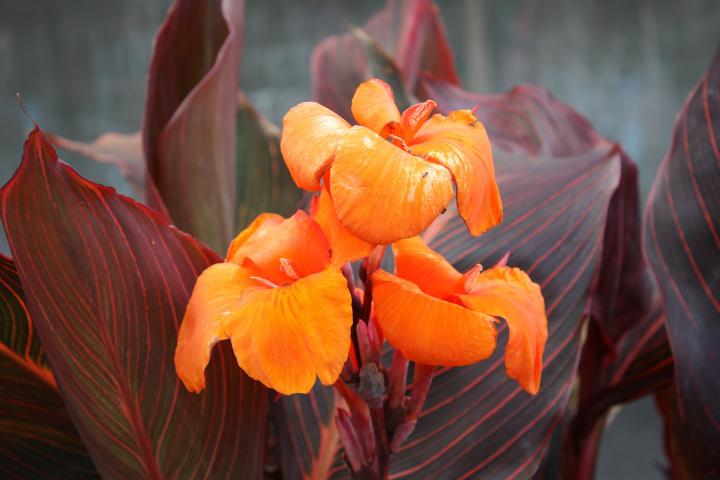
Cannas are among the most colorful summer bulbs—as flamboyant as their tropical American ancestry—with ruffled spikes tapering to refined buds.
These perennials come in a vast variety of color and boast immense, often-veined, paddle-shaped leaves and sheathing leafstalks in shades of green or bronze.
With their great reedy canes and palmy foliage, cannas would be magnificent even if they never bloomed. However, they keep blossoming from late spring or early summer to frost.
Turn-of-the-century gardeners so loved cannas that they grew them from seed but this isn’t easy; better to leave propagation to experts and buy the tubers.
Planting
- Exotic, tropical creatures, cannas need lots of sunshine and fertile, moist soil but you don’t have to pamper them.
- Cannas can be started in the house in small pots if your gardening season is short.
- Where not hardy, plant outdoors in early summer—around the same time you’d put in tomato plants.
- To plant, loosen the soil to a depth of 12 to 15 inches, then mix in a 2- to 4-inch layer of compost.
- Dig a hole 2 to 3 inches deep and set the rhizome in the hole, eyes up.
- Cover with soil and tamp firmly. Water thoroughly.
- Space rhizomes 1 to 4 feet apart.
- If you grow from seed, note that the germination rate is low and the seeds need to be filed or given an acid bath to break down their hard coat.
Care
- Cannas do best with a good supply of water, so water the plants during the summer if the rainfall is less than 1 inch per week. Water freely in a dry spell.
- Keep a thin layer of mulch around cannas to help retain moisture as well.
- Stake tall varieties if needed.
- As flowers fade, deadhead to promote continued flowering.
- Cut each stem to ground after bloom.
- After autumn frost blackens the foliage, remove the stems and leaves, and lift the rhizomes for winter storage. Store in barely-moist peat or leaf mold in frost-free conditions. Space rhizomes so that they are not touching.
- In the deep South, let cannas grow without moving them, until the clumps grow very matted. Every 3 to 4 years in the winter, dig up the clumps, separate the roots, and plant them in well-enriched soil.
- Some gardeners as low as zone 7 have reported that their cannas are getting through the winter without being dug up; just be sure to protect the tubers with a heavy layer of mulch.
Pests/Diseases
- Slugs, snails, spider mites, and caterpillars may be problems.
- Rust, fungal leaf spot, and bacterial blight are common.
- Bean yellow mosaic and tomato spotted wilt viruses can occur.
Harvest/Storage
- If you are storing cannas over the winter, store in a dry place at 45 to 50 degrees F. Don’t let them dry out; sprinkle the sand or soil around them, if necessary.
- In the spring, cut the tubers apart with a sharp knife so that each piece contains one eye on a substantial piece of rootstock.
Recommended Varieties
- Dwarf cannas stay under 3 feet tall and are easy to fit into our downsized modern gardens. The 2-½-foot-tall ‘Picasso’ is a yellow-flowered dwarf peppered with freckles.
- Standard varieties grow 4 to 6 feet tall and need a 20- to 24-inch circle for each hand-size rhizome. ‘The President’ is is red, ‘Yellow King Humbert’ spotless, ‘Rosamond Cole’ orange-edged gold, and ‘City of Portland’ salmon pink.
- Many gardeners love the spectacular, drought-tolerant varieties that reach heights of over 6 feet. One gem is the rich, deep pink ‘Los Angeles’, which has a large floret and opens out so that you can see the face.
- ‘Bengal Tiger’ is stunning even when it’s not blooming with green-and-yellow-striped, maroon-edged leaves and bright-orange flowers.
Wit & Wisdom
Flowers are words which even a babe may understand.
–Arthur Cleveland Coxe, American poet (1818-96)






